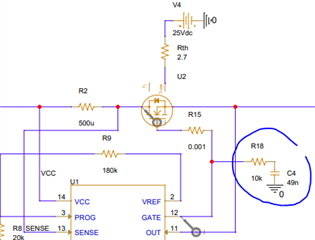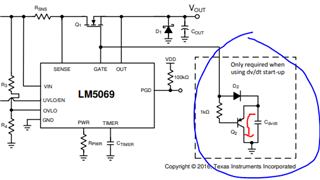Other Parts Discussed in Thread: LM5069
Good evening Rakesh, Good evening fellow forum users,
We're considering the use of the TPS2492 for our design and are simulating it under various test conditions with the PSPice model provided on your website (in PSpice for TI).
One of them is a hard output short-circuit (with the parasitics we know from previous tests). During these simulations I'm seeing a behavior of the constant power engine that I can't explain myself from the datasheet:
During the output short-circuit the voltage V(VCC-Sense) exceeds 300mV (so we're far above the overcurrent setpoint) with a V(PROG) of 0.4V (so the lower end of what you recommend). Despite these conditions that indicate a heavy output short-circuit, the TPS2492 Gate sourcing current is less than 20 mA (increasing but very slowly and not fast enough), in contrast to the 75-250 mA sinking capability given in the datasheet. This slow turn-off puts too much thermal stress on our Mosfet and if the behavior would be like this in reality, would not allow us to use the 2492.
I have seen in some other posts that for time-critical and fast-switching overcurrent protection applications you usually recommend the LM5069 (which in fact works in my simulation) but unfortunately it is not an option for us right now since the stock situation is as it is ;)
If you could advise on the reason for this behavior i'd be super thankful. We could test the circuit on a real test-board under the conditions as in the simulation however I'd only invest the time if there are any indicators for different behavior as in the simulation.
I've attached the schematic of the simulation and the relevant curves (Mosfet Drain Current, TPS2492 Gate sinking current & TPS2492 VCC-Sense voltage). I tested if it could be a violation of UVEN threshold voltage or VCC voltage, but with both of them right in spec for the 75-250mA gate sinking case, I'm seeing the < 20 mA. Please do let me know if I can provide any additional Info.
Schematic_Probes_1.pdfSchematic_Probes_2.pdf

Cheers in advance for the help!
Konstantin




